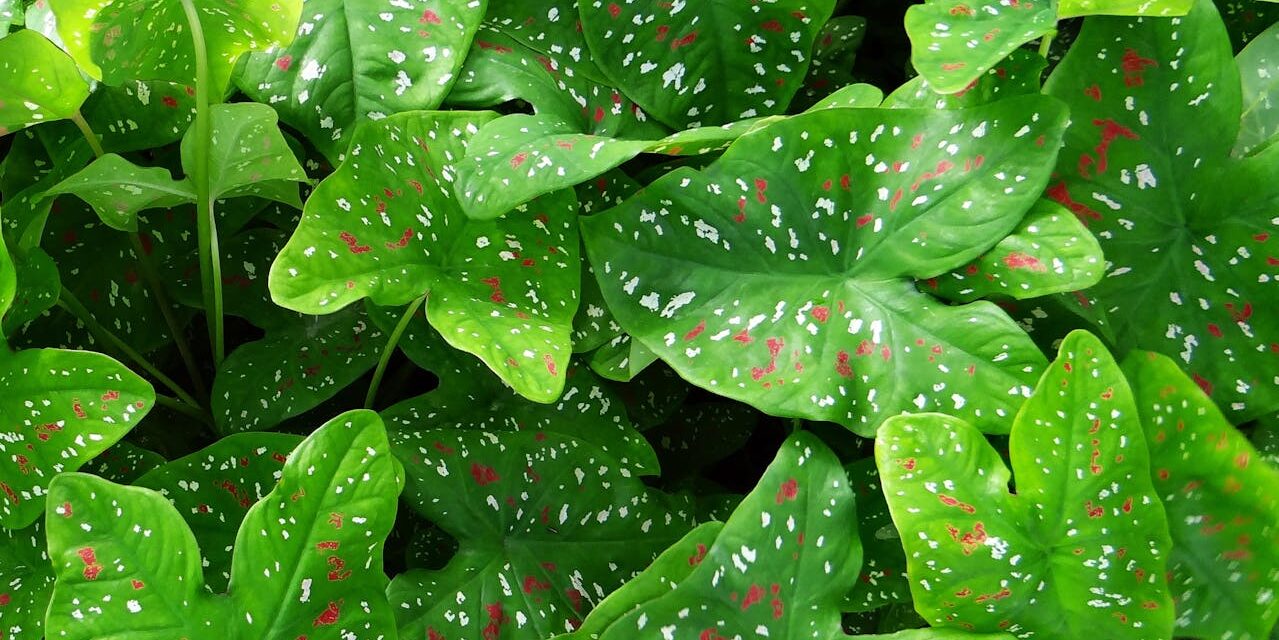Caladium houseplants are striking, big-leaved plants with various colors and markings.
Their beauty appears each year during the summer months and goes dormant through most of autumn and all the way through winter. Before I knew this, I thought my first Caladium had died, and I threw out the dirt. That was a mistake! Once the leaves die off in the fall, stop watering your Caladium, and replant in the late spring for a new round of beautiful leaves to appear.
The different types of Caladiums include Caladium picturatum, Caladium humboldtii, Caladium clavatum, Caladium andreanum, Caladium schomburgkii, Caladium ternatum, Caladium praetermissum, Caladium coerulescens, Caladium lindenii, Caladium hortulanum, and the popular Caladium bicolor.
Table of Contents
Water, Lighting & Temperature for Caladiums
Most Caladiums come in color variations of green, red, pink, and purple, with blotching or veiny patterns on the foliage’s face. With proper care and ensuring they stay away from cold temperatures, your Caladium will bring you joy and beauty for years to come.
- Water — Water throughout the week, but let the topsoil dry roughly 1/2″ from the surface before rewatering. This will keep your Caladium from getting too wet and soggy at its roots.
- Light — Caladiums’ thin, papery leaves will wilt in direct sunlight. Give your Caladium lots of indirect sun daily for the best health.
- Temperature & Humidity — Caladiums like temperatures in the 70’s (Fahrenheit), and keep them away from temperatures below 60 degrees. Caladiums also benefit from frequent misting, especially when temperatures are warmer.
- Soil — Soil for Caladiums should remain slightly moist but not sopping and well drained. pH is best at around 6.0-6.5.
- Propagation and Repotting — In the springtime, when repotting, your can split apart and plant the smaller tubers that have grown off your main Caladium.
Give your Caladium plenty of water in well-drained soil, and allow them lots of indirect light without direct, burning sun hitting its leaves.
How do you care for Caladiums?

Caladiums are generally very easy to care for and can be grown indoors and outdoors.
They thrive in warm, humid environments and prefer well-draining soil rich in organic matter. When planting caladiums outdoors, please choose a location that receives partial shade, as they do not tolerate direct sunlight well. Water your caladiums regularly to keep the soil nice and moist but not waterlogged. Fertilize your caladiums every couple of weeks during the growing season to promote healthy growth.
During the winter months, caladiums will go dormant, and their leaves will turn yellow and die back. At this time, reduce watering and stop fertilizing until the weather gets warm again in the spring.
Where do Caladiums come from?
Caladiums are native to Central and South America and grow in warm, humid environments.
They are flowering plants in the family Araceae and are known for their colorful, heart-shaped leaves. Caladiums are often grown as ornamental plants and are famous for their ability to add a tropical touch to gardens and indoor spaces.
Are Caladiums toxic to cats and dogs?
Caladiums may be toxic to cats and dogs if they ingest the plant.
While the exact toxic compound in caladiums is unknown, it is believed that they may contain calcium oxalate crystals that cause irritation and swelling of the mouth and throat, difficulty swallowing, and vomiting if ingested. It is best to keep caladiums out of reach of pets, as consuming any plant material can cause digestive upset and other health problems.
Contact your veterinarian for advice and treatment if you are concerned that your pet may have ingested caladiums.





